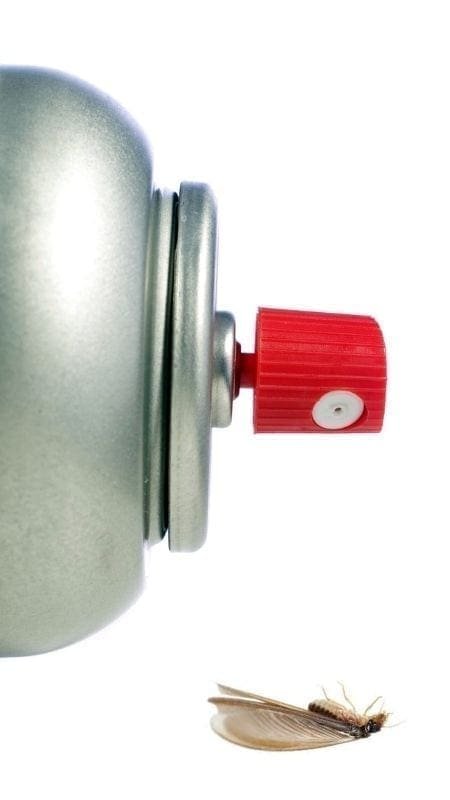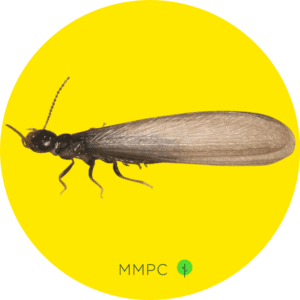
Termites are nightmare for homeowners across the country, including here in New York and Long Island. Each year, these wood-destroying pests do more damage to homes than fires.
During the spring, termites come out in swarms to reproduce and expand their colonies. Seeing these termite swarmers is a bad sign that a colony may be nearby, underneath, or inside your home.
Here’s what you should know if you’ve discovered termite swarmers, which resemble flying ants, around your home or property.
What are Termite “Swarmers”?
Termite swarmers, also known as alates, are the reproductive members of a termite colony. Unlike worker or soldier termites, they have two pairs of large, pale wings.
Because of their appearance, people often confuse them with flying ants.
Swarmers do not bite, sting, or eat wood; their only purpose is to leave the colony during the swarming season to find mates and establish new colonies through reproduction.
When Does Termite Swarming Season Start?
Spring weather signals the start of termite swarming season, especially for the subterranean termites commonly found in areas around New York City.
Swarmers tend to emerge in large groups during the early spring when temperatures begin to reach 70 degrees Fahrenheit, and swarming can continue to occur several times more times throughout the year.
Finding termite swarmers inside your home is often the sign of an active termite infestation.
If you see or suspect swarmers on your property, it’s a good idea to contact your local exterminator or termite control company for an inspection.
Where do Termite Swarmers Come From?
Termite swarmers are a sign that a termite colony may be inside or near your home. Where you find the swarmers (or signs of them) can tell you where they are coming from.
- If you see swarmers outside your home, they are likely to be from a colony in your yard or a nearby yard. Swarmers are poor fliers and typically do not travel further than 300 ft away from the original colony.
- If you see swarmers inside your home, this indicates that a colony might be located inside or underneath your home. You should check for other signs of termites (see below) or contact a termite control professional for an inspection.
Swarmers are produced after the colony has reached maturity, which can take up to 4 years. This means that termites can do a considerable amount of structural damage to your home or property before swarmers are detected.

Will Killing the Swarmers Solve the Problem?
No. Termite swarmers found inside your home are usually symptomatic of an existing infestation.
Killing the swarmers themselves will not eliminate any established termite colonies inside or near your home.
In fact, using over-the-counter aerosols to spray swarmers might damage or stain building materials and will result in a difficult-to-clean mess. Therefore, we do not recommend trying to spray the swarmers yourself.
Instead, contact your local pest control professional to help you remove them. Or you can wait for the swarmers to die naturally, which usually happens in a few days, and use a vacuum cleaner to clean them up.
Common Signs of Termite Swarmers
1. “Flying Ants”
Oftentimes, swarmers are mistaken for flying ants. Termites are sometimes referred to as white ants, even though they bear no relation.
One way to differentiate these insects is by wing size and shape. Termites’ wings are all the same size whereas ants have a set of large wings paired with a set of smaller wings.
If you see these insects in or near your home, you should seek out other signs of termite activity to determine which species is present.
2. Discarded Insect Wings
After swarmers find mates, they shed their wings. Keep an eye out near windowsills and other entryways for abandoned or discarded insect wings.
Termite swarmer wings are pale-colored and are typically 1/4 to 1/2 inches long.
3. Other Signs
- Damaged wood in or around your home.
- Mud tubes inside your home or around the exterior of your home.
- Frass, or termite droppings, which are dry and pellet-shaped (depending on the species) and can look like sawdust or sand.
- More signs of termites

How Can I Protect My Home From Termites?
Termites primarily consume cellulose found in wood, but they will eat through other building materials just to get to it. Termites do not sleep, they munch 24/7, and cause billions of dollars in property damage annually.
Here are some steps you can take to prevent future damage and protect your home from termites:
- INSPECT your home for signs of termites. This includes hollow wood, bubbling paint, frass, mud tubes, and other wood damage in your home. Termite infestations can be hard to diagnose. NMPA (the National Pest Management Association) recommends contacting a termite management specialist for assistance.
- DRAIN – Make sure all water is draining away from your home. This keeps the soil near your home and your home dry and therefore not an ideal environment for most termites.
- REPLACE any damp or damaged wood on or around the exterior of your home, porch, and storage areas.
- WOOD SCRAPS – Don’t leave wood scraps in your yard or close to your home. If you store wood outside for an indoor fireplace, be sure to keep this wood dry and covered, and carefully inspect the firewood before bringing it inside your home.
- SEAL cracks and crevices inside and outside your home.
There are over 2,000 species of termites and different species may call for different solutions. Depending on which species you are dealing with, they may prefer a damper or drier climate.
In New York, the most common type of termite is the subterranean termite.
Termite Control, Inspection, and Treatment in NYC
If you’re looking for reliable termite control in New York City or the Tri-State Area, contact MMPC today! We have 25+ years of experience providing certified termite inspections and solutions.
If you’ve found an insect that you suspect might be a termite or a termite swarmer, send a picture to us through our Free Pest ID Center and we’ll be happy to identify it for you.

